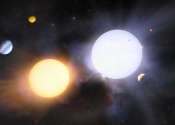Researchers create new software for the new European-Japanese Earth observation satellite EarthCARE
Preparations for the launch of the new Earth observation satellite EarthCARE (Earth Cloud Aerosol and Radiation Explorer) at the end of May are in full swing. The joint mission of the European Space Agency (ESA) and the Japan ...









